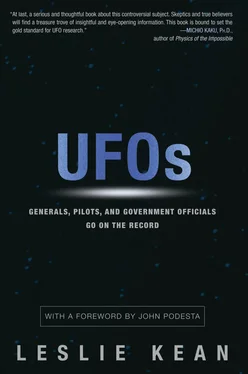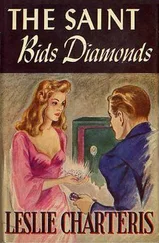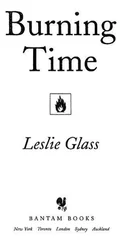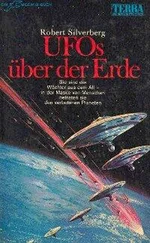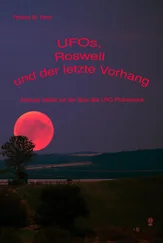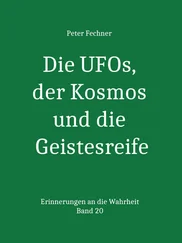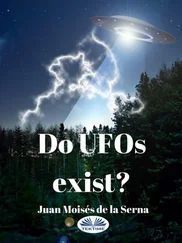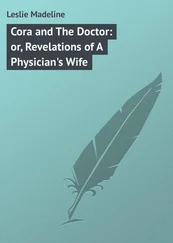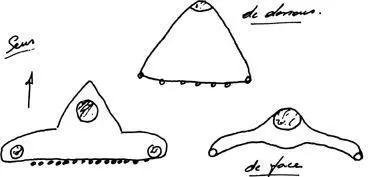
The craft from three angles, drawn by a boy in Trooze, near Liège . SOBEPS archives
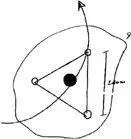
Colonel Amond sent his drawing of the UAP’s ventral side to the Belgian minister of defense . A. Amond
There was no sound and, although it was a full moon, the witnesses didn’t see the structure of the craft. After completing its turn, it suddenly accelerated very rapidly, only to vanish in the darkness of the night. Colonel Amond sent a detailed report to the Belgian defense minister. He ascertained that this craft was not a hologram, helicopter, military aircraft, balloon, motorized Ultra Light, or any other known aerial vehicle.
During a recent review of the investigation, it was learned that another witness had seen the object with three bright lights and a pulsating red light approximately five minutes before Amond and his wife. The exact timing could be reconstructed because she was walking home from the train that arrived at Ernage railway station twenty minutes before the Amonds spotted the craft.
On April 4, 1990, at 10:00 p.m. in the town of Petit-Rechain, a lady was walking her dog in her courtyard when she noticed the spotlights of a craft hovering above her home. She alerted her partner, who rushed outside with his newly bought camera. The camera was loaded with color slides, but only two shots remained on the film. Leaning against the wall to avoid instability, he took two photographs, the first with a manual exposure time of one to two seconds, while the craft was banking to the left. Subsequently, it started moving and disappeared out of sight behind the nearby houses. After the film was processed, the photographer saw four light spots on one slide and nothing on the second, which he threw away.
Several weeks later, he showed the remaining photograph to his fellow metalworkers during their lunch break in the factory. One of his friends contacted a local journalist, who published the photograph in a French magazine. From there, Belgian military academy experts were notified and requested the original slide for analysis. A team under the direction of Professor Marc Acheroy discovered that a triangular shape became visible when overexposing the slide.
After that, the original color slide was further analyzed by François Louange, specialist in satellite imagery with the French national space research center, CNES; Dr. Richard Haines, former senior scientist with NASA; and finally Professor André Marion, doctor in nuclear physics and professor at the University of Paris-Sud and also with CNES.
The major findings were:
• No effect of infrared radiation.
• No indication of any tampering with the slide.
• The camera was stable, but the craft was moving slowly and had approximately a 45-degree bank when the picture was taken.
• The rotation of the spotlights did not occur around one central point.
• The middle light is very different from the three other lights.
• The lights are positioned symmetrically with respect to the structure of the craft.
Professor Marion’s more recent analysis in 2002 used more sophisticated technology. He confirmed the previous findings, while explaining a new discovery: Numeric treatment of the photograph revealed a halo of something lighter surrounding the craft. Special optical processing shows that within the halo, the light particles form a certain pattern around the craft like snowflakes in turbulence. This is very similar to the pattern of iron filings which is caused by “the lines of force” in a magnetic field. [12] 2 “the lines of force” in a magnetic field André Marion, “Nouvelle Analyse de la Diapositive de Petit-Rechain” (A New Analysis of the Petit-Rechain Slide), Orsay, January 17, 2002.
This could indicate that the craft is moving by using a magnetoplasmadynamic propulsion system as suggested by Professor Auguste Meessen [13] 3 as suggested by Professor Auguste Meessen Auguste Meessen, professeur emeritus at the University of Louvain, “Réflexions sur la propulsion des Ovnis” (Reflections on UFO Propulsion), http://www.meessen.net/AMeessen/ReflexionPropulsion.pdf .
in one of his studies.
Many hidden elements were revealed only through the analysis of this photograph, showing that the picture was not faked. The experts noted especially that the unique characteristics of the lights are very specific and said such an effect would not occur if the picture was a hoax. [14] 4 such an effect would not occur if the picture was a hoax Translated text of Professor Marion: “It seems difficult to envisage a hoax created with a model or other similar device. This is confirmed by the digital analysis (see further)… The existence of the ‘lines of force’ is a strong argument against the thesis of a hoax, which would be particularly sophisticated. Moreover, it is unclear why a forger would have bothered to imagine and realize a complex phenomenon, especially since it is not noticeable without sophisticated processing of the slide.” Marion, ibid.
Also, the findings of the experts are consistent with the account of the photographer, who initially didn’t think much of his shot of four strange lights and kept it in a drawer for weeks before showing it to anyone. He was not sure what it was, and for a while had not given it much thought.
Although the vast majority of the reports described a triangular craft with three spotlights and one flashing light at the bottom, as was captured in the Petit-Rechain photograph, a number of witnesses reported very special shapes and characteristics. On April 22, 1990, seven reports of triangles were submitted plus a more unusual report by two workers in Basècles, southwest of Brussels. They were in their factory courtyard shortly before midnight, when suddenly two enormous bright spotlights appeared, illuminating the courtyard. A huge trapezoid platform moved very slowly and silently slightly above the chimney, at one point covering the whole courtyard (100 × 60 meters, or 330 × 200 feet). The two men described six lights and said the color of the object was grayish. They saw structures at the bottom of the platform that looked to them like “an aircraft carrier turned upside down.”
Another peculiar sighting, strikingly similar to the one at the Basècles factory, occurred on March 15, 1991, in Auderghem, near Brussels. An electronic engineer woke up during the night and heard a barely audible, high-frequency whistling tone. He looked out the window and saw a large rectangular craft at very low altitude with irregular structures on the bottom. Slipping on a jacket, he went upstairs to an upper-level terrace and watched the dark gray craft drift overhead very slowly without lights. The whistling tone had stopped and the craft was now silent.
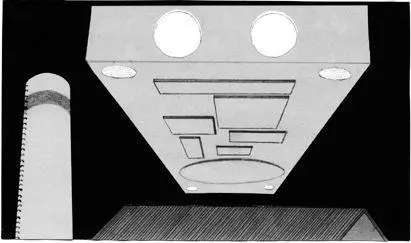
An artist’s rendition of the “inverted aircraft carrier” at the Basècles factory . SOBEPS archives
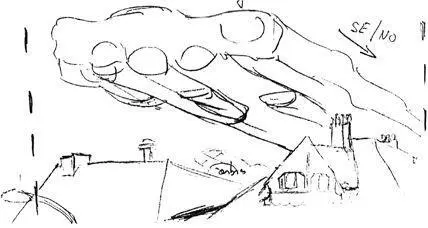
A witness’s drawing of a rectangular craft over Auderghem, similar to the craft seen at Basècles a year prior . SOBEPS archives
A few days before, on March 12, 1991, a total of twenty-seven reports were filed from a small area southwest of Liège. On two occasions a craft was seen over the nuclear power plant of Thiange. One witness reported that it was directly above the red lights on the top of one of the enormous chimneys. It hovered there for approximately one minute, beaming one of its lights on the outside structure while another light pointed directly into one of the chimneys. After it had finished its “inspection,” the UAP started moving slowly and flew straight through the enormous white plume of the chimney before disappearing in the dark.
Читать дальше
